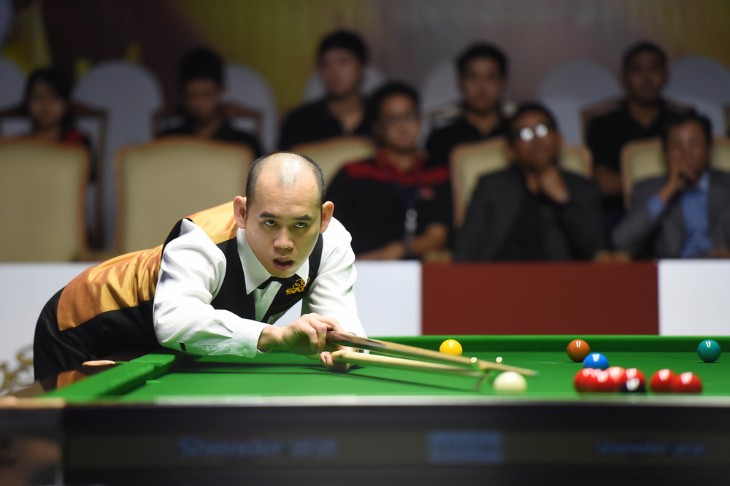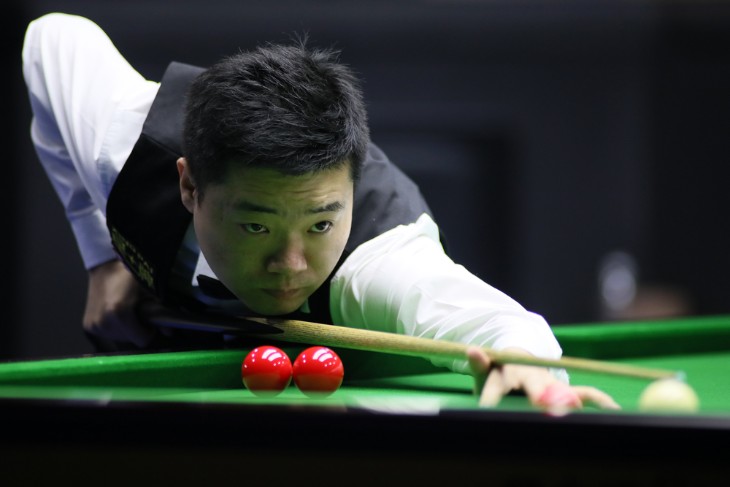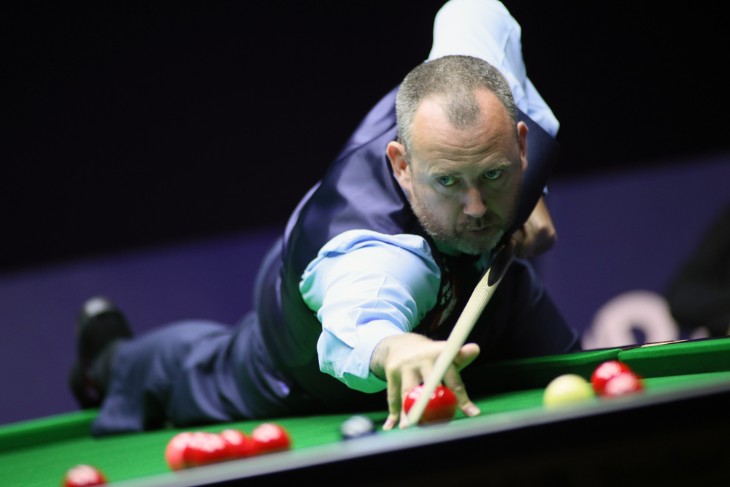- Understanding Cue Ball Spin
- Grip and Stance for Spin Shots
- The Role of Chalk in Spin Shots
- English - Adding Side Spin to Your Shots
- Top Spin and Back Spin Techniques
- Practicing Spin Shots on the Practice Table
- The Importance of Aiming and Target Points
- Using the Cushions to Your Advantage
- Advanced Spin Shot Strategies
- Common Mistakes to Avoid in Spin Shots
- Developing Consistency in Your Spin Shots
- Conclusion
In the world of snooker, mastering the art of spin shots is a fundamental skill that distinguishes the proficient players from the novices. Spin shots, also known as "English" in snooker terminology, involve imparting a controlled spin on the cue ball to influence its trajectory and positioning after it makes contact with an object ball. Understanding the basics of spin shots is crucial for players looking to take their game to the next level.
To execute a successful spin shot, one must first comprehend the physics at play. The cue ball's spin is achieved by striking it off-center, away from its central axis. This off-center impact causes the cue ball to spin, and the direction and amount of spin depend on various factors, including the point of contact, the angle of the cue, and the speed of the strike. It is essential to note that spin shots are not only about adding spin but also about controlling its intensity and direction, which makes mastering this skill a nuanced endeavor.
A key component of executing spin shots effectively is the choice of cue tip material and the application of chalk. The cue tip, often made of leather, must be properly chalked before each shot to reduce friction between the cue ball and the tip. This reduced friction allows for better grip on the cue ball and enhances the spin effect. Therefore, maintaining a well-chalked cue tip is a foundational aspect of successful spin shot techniques.
Understanding Cue Ball Spin
Cue ball spin is categorized into two primary types: side spin and top spin/backspin. Side spin, as the name suggests, involves imparting a lateral spin to the cue ball, causing it to move to the left or right upon contact with an object ball or cushion. This spin is achieved by striking the cue ball off-center horizontally. Conversely, top spin and backspin involve striking the cue ball above or below its center, respectively. Top spin causes the cue ball to follow through and roll forward after contact, while backspin results in a backward roll upon impact.
To visualize the effects of cue ball spin, consider a shot where a player wants to pot a red ball and position the cue ball for the next shot. By applying left-side spin (left English), the cue ball will veer to the left after striking the red ball, potentially allowing for a more advantageous position on the black ball. Conversely, right-side spin (right English) will yield a similar effect to the right.
Grip and Stance for Spin Shots
Achieving precision and control in snooker spin shots heavily relies on a player's grip and stance. These elements form the basis of shot consistency and can significantly impact the amount of spin applied to the cue ball.
Starting with the grip, snooker players commonly adopt a relaxed yet firm grip on the cue. The bridge hand, which supports the cue, should form a stable base. The grip hand, on the other hand, should lightly cradle the cue, allowing for a fluid and unhindered follow-through during the shot. When it comes to spin shots, maintaining a consistent and relaxed grip is paramount. Gripping the cue too tightly can result in unwanted tension, affecting the player's ability to strike the cue ball precisely and apply the desired spin. Conversely, an overly loose grip can lead to an erratic stroke and a loss of control.
A player's stance also plays a pivotal role in executing spin shots effectively. A balanced and stable stance provides the foundation for a controlled shot. The feet should be shoulder-width apart, with the dominant foot slightly forward. The body should be aligned with the shot, and the head should be positioned directly over the cue. A well-balanced stance ensures that the player's weight is evenly distributed, reducing the chances of swaying or leaning during the shot. For spin shots, maintaining this stability is vital, as any unnecessary body movement can disrupt the accuracy of the shot.

The Role of Chalk in Spin Shots
In the realm of snooker, chalk is not merely a cosmetic accessory but a critical component in cue ball control, especially when it comes to spin shots. The application of chalk to the cue tip is a routine practice that helps reduce friction between the cue tip and the cue ball, facilitating precise spin application.
Chalking the cue is a process where players lightly rub the cue tip with a piece of chalk before every shot. This application of chalk provides a smoother interaction between the cue tip and the cue ball, ensuring that the tip can grip the ball effectively. Without proper chalk, the cue tip can slide or slip on the cue ball, leading to unpredictable outcomes in terms of spin and shot accuracy.
When applying chalk for spin shots, players should ensure even coverage across the cue tip's surface. This uniformity guarantees consistent spin application during shots. It's essential to strike a balance, as excessive chalk can result in a chalky residue on the cue ball, affecting its trajectory. Conversely, too little chalk can lead to inadequate grip, reducing the spin effect. Mastery of chalking techniques is a crucial aspect of spin shot proficiency, and players often develop their preferences for the right amount of chalk based on experience and personal playing style.
English - Adding Side Spin to Your Shots
In the realm of snooker, the term "English" refers to the application of side spin to the cue ball. This technique allows players to manipulate the cue ball's trajectory, making it veer to the left or right upon contact with an object ball or cushion. Understanding how to add side spin effectively is a hallmark of skilled snooker players.
The key to adding side spin lies in the point of contact between the cue ball and the cue tip. To impart left-side spin (left English), the cue tip must strike the cue ball slightly to the right of its center. Conversely, for right-side spin (right English), the cue tip should contact the cue ball slightly to the left of its center. The amount of side spin applied depends on several factors, including the angle of the cue, the speed of the strike, and the follow-through.
One crucial element in mastering side spin shots is the angle of deflection. When a cue ball with side spin contacts an object ball, it deviates from its natural path, influenced by the spin. Understanding this angle of deflection is vital for precise positional play. Skilled players use side spin to pot balls and position the cue ball for subsequent shots, demonstrating the intricacy and strategic importance of this spin technique in snooker.
Top Spin and Back Spin Techniques
In snooker, spin shots are not limited to side spin. Top spin and backspin, also known as follow and draw shots, respectively, are essential techniques that add depth and control to a player's repertoire. These shots involve striking the cue ball above (top spin) or below (backspin) its center, and each has its unique characteristics.
Top spin, often referred to as a "follow shot," is used to make the cue ball roll forward after contacting an object ball. To apply top spin effectively, the cue tip should strike the cue ball just above its center. This imparts a forward rotation to the cue ball, causing it to travel further than it would with a standard, no-spin shot. Skilled players employ top spin to navigate the snooker table with precision, position the cue ball for their next shots, or pot balls with controlled follow-through.
Conversely, backspin, or a "draw shot," is executed by striking the cue ball below its center. This imparts a backward rotation to the cue ball, causing it to reverse its direction upon contact with an object ball or cushion. Draw shots are valuable for bringing the cue ball back into position or holding it for specific shots. Mastering the application of backspin requires precision in cueing and follow-through, ensuring that the spin effect is consistent and controlled.
Practicing Spin Shots on the Practice Table
One of the most effective methods of practicing spin shots is through the use of drills and exercises. These drills are designed to isolate specific aspects of spin, allowing players to refine their control over cue ball spin, direction, and speed. For instance, a common drill involves setting up a sequence of balls on the table and practicing potting them while applying various types of spin. This not only helps in mastering spin but also enhances the player's ability to position the cue ball precisely for the next shot. Dedicated practice sessions like these contribute significantly to muscle memory, making it easier to execute spin shots confidently during actual gameplay.
It's also worth mentioning that practice should encompass all aspects of spin shots, including grip, stance, and cueing technique. Players should aim to maintain consistency in these fundamental elements while refining their spin application. Furthermore, practicing on different areas of the table and under various conditions (e.g., with different cloth types or humidity levels) can further enhance a player's adaptability and overall skill level.
The Importance of Aiming and Target Points
To execute spin shots effectively, a player must visualize the point on the object ball where they intend to make contact. This point is often referred to as the "contact point" or "target point." The target point varies depending on the desired outcome of the shot, such as potting a ball or positioning the cue ball for the next shot. For instance, when adding side spin to pot a ball into a corner pocket, players must identify the precise point on the object ball that, when struck, will achieve the desired angle and spin effect.
Aiming systems, such as the ghost ball method or the fractional aiming system, provide players with structured approaches to identifying target points. These systems take into account cue ball and object ball positions, angles, and spin requirements. Through practice and experience, players develop the ability to quickly assess the optimal target point for a given shot. This skill is honed over time and is a critical factor in a player's consistency and success in snooker spin shots.
Using the Cushions to Your Advantage
A distinctive feature of snooker is the use of cushions, or rails, that encircle the table. These cushions play a significant role in both offensive and defensive aspects of the game and are integral to mastering spin shots.
For offensive play, cushions can be a valuable tool for skilled players looking to position the cue ball precisely. By applying spin and striking the cue ball at specific angles, players can utilize the cushions to redirect the cue ball towards their desired target. This technique, often referred to as "cushion work," allows players to navigate around obstructing balls, pot balls with finesse, and gain advantageous positions for subsequent shots. Understanding the physics of cushion rebound and practicing cushion shots are essential components of a player's repertoire.
Defensively, cushions also play a role in snooker strategy. Skillful use of cushions can lead to effective snookering, where a player leaves their opponent in a challenging position by hiding the cue ball behind a cushion or other balls. Spin shots can be employed to achieve precise snookers, making it exceedingly difficult for the opponent to escape from such situations. The ability to judge the angle of cushion rebound and apply spin strategically is, therefore, a key element of a player's defensive tactics.
Advanced Spin Shot Strategies
One advanced spin shot strategy is the use of spin to control cue ball speed. By applying precise amounts of top spin or backspin, players can control the speed at which the cue ball travels after contacting an object ball. This ability to control cue ball speed is invaluable for positioning the cue ball for the next shot or for executing intricate positional play, such as cannons and splits. Advanced players often use these techniques to break clusters of balls, create openings, or achieve better positioning on the black ball.
Additionally, advanced spin shot strategies include the manipulation of spin to create angle variations. By combining side spin with top or backspin, players can create angular deflections that are difficult for opponents to predict and counter. This element of unpredictability can be a powerful tool in strategic snooker play, allowing players to gain an upper hand by confounding their opponents and setting up challenging situations on the table.

Common Mistakes to Avoid in Spin Shots
One prevalent mistake is overcomplicating spin shots. Novice players often attempt to apply excessive spin or spin in multiple directions, leading to a loss of control and accuracy. Instead of trying to execute intricate spin shots, players should start with the basics and gradually build their skills. It's essential to remember that simplicity often leads to consistency in snooker.
Another common error is neglecting the fundamentals of grip, stance, and cueing. Even when focusing on spin shots, these fundamental aspects play a critical role in shot execution. Failing to maintain a proper grip, stable stance, or consistent cueing technique can result in unpredictable spin application and inaccurate shots. Therefore, players should continuously practice and refine these foundational elements in conjunction with spin shot practice.
Furthermore, misjudging the amount of spin required for a shot is a common mistake. Players may apply too much or too little spin, resulting in unintended outcomes. Developing a keen sense of spin intensity and the ability to adapt to various shot scenarios is essential for avoiding this pitfall.
Developing Consistency in Your Spin Shots
Developing consistency in spin shots requires a systematic approach to practice and refinement. Players should focus on repetition, honing their muscle memory to execute spin shots with precision and reliability. Regular practice sessions that incorporate drills specifically designed for spin shot improvement can help achieve this consistency.
Furthermore, players should maintain a meticulous record of their practice and gameplay. By tracking their performance, players can identify patterns, strengths, and weaknesses in their spin shot execution. This data-driven approach allows for targeted improvement in areas that require attention.
Consistency also extends to mental aspects of the game. Maintaining composure, focus, and confidence during competitive play is crucial for consistent spin shot execution. Techniques such as mindfulness, mental imagery, and controlled breathing can assist players in staying mentally sharp and enhancing their overall consistency on the snooker table.
Conclusion
In conclusion, mastering snooker spin shots is a journey that requires dedication, practice, and an understanding of the nuances involved. By addressing common mistakes, striving for consistency, and continuously refining their techniques, players can elevate their spin shot skills and enhance their overall performance in the game of snooker.
For more information:











